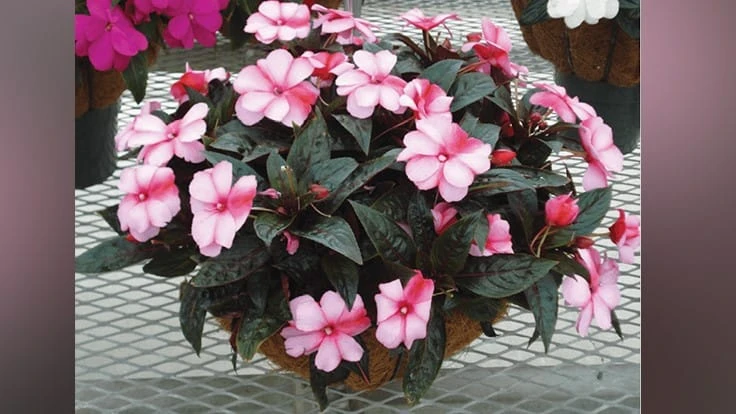

New Guinea impatiens are one of the most popular bedding plants. Their attractive foliage and large, colorful and plentiful flowers have made them an important annual crop for growers. While they are not the hardest crop to produce, they are not without their challenges. This article highlights the top “Do’s and Don’ts” for producing high-quality New Guinea impatiens.
Temperature
Compared to most herbaceous annuals, New Guinea impatiens are a warm-growing crop and are sensitive to cold temperatures. Their optimal temperature, the rate at which growth is fastest, is around 75° to 80° F, whereas temperatures below 60° F can slow down growth. Day temperatures between 68° and 75° should be targeted. When rooted cuttings are first transplanted, it is best to maintain night temperatures at or above 63° F to get them established. Once root systems have established and shoot growth resumes, night temperature can be lowered slightly but should still be maintained at or above 60° F.
Light
New Guinea impatiens are day-neutral plants and can flower under a range of day lengths. However, plant growth and flowering do respond to the daily light integral (DLI). A DLI of 4 mol·m–2·d–1 is required for a minimally acceptable crop. While good- and high-quality crops are grown under 6 to 8 mol·m–2·d–1 and 10 to 15 mol·m–2·d–1, respectively, avoid DLIs higher than this. Some of the newer varieties of New Guinea impatiens developed for full sun can be grown under higher DLIs, as these plants are more adapted to the stronger light intensity compared to traditional green- and bronze-leaf cultivars.
Water
It is best to grow them on the slightly drier side right after transplanting cuttings to let their root systems establish. Overwatering at this stage can slow roots down from developing. Once established, the substrate can be kept more moist than it normally would be. New Guinea impatiens growth responds positively to irrigation, and they are provided with as much water as they can take up, growth is pushed to the point of being excessive. Therefore, restricting excessive irrigation is one effective method of non-chemical growth control for this crop. However, be careful in moderating New Guinea impatiens substrate moisture. If they are repeatedly dried down too hard, plants will suffer and can collapse from repeated stress.

Nutrition
One key to finishing New Guinea impatiens is to avoid over-fertilizing plants during production. New Guinea impatiens are light-feeding plants, growing best with a substrate electrical conductivity (EC) between 1.0 and 2.5 mS/cm using the PourThru test. Providing too much fertilizer and allowing substrate EC to get too high can result in salt-stressed and damaged plants. Once cuttings are transplanted, fertilizer applications are not required for the first few weeks as plants establish, especially if the substrate has a starter charge. As plants establish and start growing, fertilizer can start to be applied. Using 100 to 200 ppm Nitrogen (N) at each irrigation, depending on irrigation leaching fraction, is sufficient. To avoid high salts, incorporating clear water irrigations and leaching with clear water is useful. In addition to managing EC, maintain substrate pH between 5.8 and 6.2. Too much fertilizer, or a pH below 5.8, may cause micronutrient toxicities.
Growth regulation
From propagation through finishing, New Guinea impatiens can be produced with little to no plant growth regulator (PGR) application. Cuttings root without any rooting hormone application. After planting, neither a mechanical pinch nor branching PGR is needed since modern cultivars are free-branching. New Guinea impatiens generally do not require growth regulators to control growth, as this can usually be accomplished through cultural factors such as managing irrigation. Should chemical growth regulation be required, paclobutrazol sprays (1 to 15 ppm) are recommended. For large containers with long crop times, ethephon sprays (up to 300 ppm) may be applied to abort flowers and buds and to keep plants vegetative as they are bulked up.
Pests and diseases
Tomato spotted wilt virus (TSWV) and impatiens necrotic spot virus (INSV) are two particularly devastating viruses for New Guinea impatiens crops. Rigorously inspecting incoming cuttings and rooted liners for the necrotic lesions and concentric rings. Additionally, stay on top of thrips control, as they are vectors for TSWV and INSV and can transmit the viruses to otherwise healthy plants. Also keep an eye on root rots that may develop in New Guinea impatiens crops resulting from their water requirements.
To avoid high salts, incorporating clear water irrigations and leaching with clear water is useful.
Take-home
Well-grown New Guinea impatiens can be show-stopping plants on the bench. By providing adequate heat and light and adequate moisture, limiting excess fertilizer and drops in pH, and staying ahead of thrips and root rots, New Guinea impatiens can finish strong for strong spring sales.

Explore the March 2020 Issue
Check out more from this issue and find your next story to read.
Latest from Greenhouse Management
- Anthura acquires Bromelia assets from Corn. Bak in Netherlands
- Top 10 stories for National Poinsettia Day
- Langendoen Mechanical hosts open house to showcase new greenhouse build
- Conor Foy joins EHR's national sales team
- Pantone announces its 2026 Color of the Year
- Syngenta granted federal registration for Trefinti nematicide/fungicide in ornamental market
- A legacy of influence
- HILA 2025 video highlights: John Gaydos of Proven Winners





